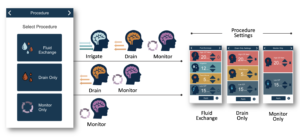Elevated intracranial pressure (ICP) is a common cause of neurological damage and death in patients with any neurosurgical disorder. Continuous ICP monitoring has been clinically proven in studies since 2012 to decrease patient mortality rates.1

ICP monitoring and fluid drainage are often performed by two separate catheters that must be placed within a patient’s brain, but IRRAflow® combines drainage and pressure monitoring into one integrated fluid management system. This innovative, new monitoring system automates pressure data collection, allows for custom alarms when pressure rises, and can actively manage ICP through its proprietary fluid exchange technology. The system has also been designed with an intuitive, touch screen interface that is designed to reduce the burden of care on Neuro ICU staff.
For other systems that also combine drainage and pressure monitoring into one solution, these technologies are frequently interrupted by catheter blockage. Catheter blockages place the patient at risk by not allowing fluid to drain, which can quickly increase pressure in the brain resulting in a poor outcome for the patient. Furthermore, if the drainage catheter is occluded, accurate pressure measurements cannot be performed, and the catheter must be quickly manually flushed or replaced, which can increase the risk of infection.
Given the vital importance of these drainage systems to function properly, it is critical to address the clinical challenges that have plagued these devices. The IRRAflow technology has been designed to meet these challenges.
1. Yuan Q, Wu X, Sun Y, et al. Impact of intracranial pressure monitoring on mortality in patients with traumatic brain injury: a systematic review and meta-analysis. J Neurosurg. 2015;122:574–87.